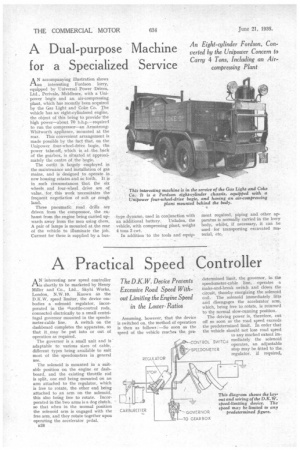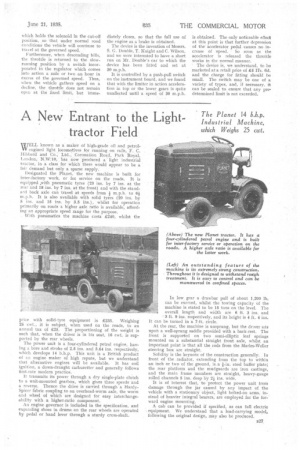A Practical Speed Controller
Page 40

Page 41

If you've noticed an error in this article please click here to report it so we can fix it.
AN 'interesting new speed controller is shortly to be marketed by Henry Miller and Co., Ltd., Skyhi Works, London, N.W.10. Known as the D.K.W. speed limiter, the device embodies a solenoid regulator, incorporated in the throttle-control rods, connected electrically to a small centrifugal governor mounted in the speedo
meter-cable line. A switch on the dashboard completes the apparatus, so that it may be put into or out of operation as required.
The governor is a small unit and is adaptable to various sizes of cable, different types being available to suit most of the speedometers in general use.
The solenoid is mounted in a suitable position on the engine or dashboard, and the existing throttle rod is split, one end being mounted on an arm attached to the regulator, which is free to rotate, the other end being attached to an arm on the solenoid, this also being free to rotate. Incorporated in the two arms is a dog clutch, so that when in the normal position the solenoid arm is engaged with the free arm, and they rotate together upon operating the accelerator pedal.
a26
Assuming, however, that the device is switched on, the method of operation is then as follows :—So soon as the speed of the vehicle reaches the pre determined limit, the governor, in the speedometer-cable line, operates a make-and-break switch and clrlses the circuit, thereby energizing the solenoid coil. The solenoid immediately lifts and disengages the accelerator arm, which, being free to rotate, is returned to the normal slow-running position. The driving power is, therefore, cut off so soon as the road speed exceeds the predetermined limit. In order that the vehicle should not lose road speed. to any marked extent immediately the solenoid operates, an adjustable stop may be fitted to the regulator. if required,
CONT ROL SWITCTI SPEE DOMET ER
which holds the solenoid in thecut-off position, .so that under normal road conditions the vehicle will continue to travel at the governed speed.
Furthermore, when descending hills, the throttle is returned to the slowrunning position by a switch incorporated in the regulator which comes into action a mile or two an hour in excess of the governed speed. Thus, when the vehicle gathers speed on a decline, the throttle does not remain open at the fixed limit, but Imme
diately closes, so that the full use of the engine as a brake is obtained.
The device is the invention of Messrs. S. G. Double, T. Knight and C. Wilson, and we were interested to have a short run on Mr. Double's car to which the device has been fitted and set at 30 m.p.h.
It is controlled by a push-pull switch on the instrument board, and we found that with the limiter in action acceleration in top or the lower gears is quite unaffected until a speed of 30 m.p.h.
is obtained. The only noticeable effect at this point is that further depression of the accelerator pedal causes no increase of speed. So soon as the accelerator is released the throttle Works in the normal manner,
The device is, we understand, to be marketed at a retail price of £4 17s. (Id. and the charge for fitting should be small. The switch may be one of a variety of types, and, if necessary, it can be sealed to ensure that any predetermined limit is not exceeded.




























































































